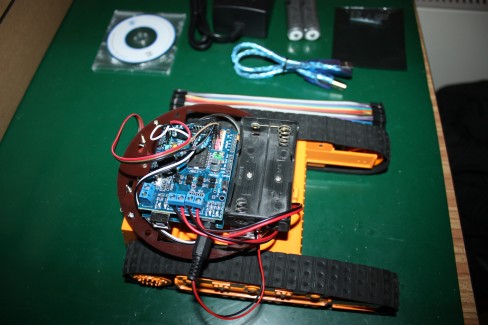TechnoTank
I'm involved with a computer science outreach collaboration for 11-19 year olds at my University. One of our most recent initiatives involves developing robots at an after school club. We've been playing with a number of off the shelf and custom built chassis. One of the most recent is a tracked based vehicle from Lightake: http://lightake.com/products.do/category.Wholesale_Arduino___SCM_Supplies-738
Features
The goal of this robot is to provide a demonstration of bidrectional communication over bluetooth; having an Android app that can display sensor values and allow control of the robot. I also teach Android programming as a part of the outreach group.
The base kit has an Arduino Uno and ArduMoto board, with some RGB LEDs and a bluetooth chip. We plan to add:
- Pan/tilt servo arm for SRF-04 ultrasound sensors
- Temperature Sensor
- Xbee (for s4a interaction)
- Arm & claw
Construction
02/12/2012
One thing I find difficult in our after school club is the amount of effort required in getting a group of younger students to construct a chassis. This particular kit came pre-assembled (seems to be repurposed toy) with motor controller and arduino hooked up and a demo program running. Which is a nice easy way to get kids enthusiastic. We have an approximate budget of £60 per robot, though this varies depending on the initiative a student can show in their design and planning.
The chassis isn't large, but as I said, it looks like a repurposed toy, in fact there is a unused battery slot on the underside, so with some moving around we should be able to comfortably fit two arms - one for ultrasound and one for a claw. There are servo sized slots in the acrylic (one currently covered by the battery pack).
More updates to come soon I hope; our club runs on Wednesdays.
04/12/2012
Using some LDRs, I've given the robot a photophillic behaviour - something I implemented on my Demonbots (which I will submit soon) many months ago. You may have seen such robots referred to as Braitenberg vehicles. Kids absolutely love playing with them, and it's a nice demo of artificial intelligence if you're presenting computer science to a young audience.
A really great feature when get started - especially since it can also be a good introduction to BEAM.
Android remote control, object avoidance
- Power source: 2x18650
- Programming language: Arduino C


